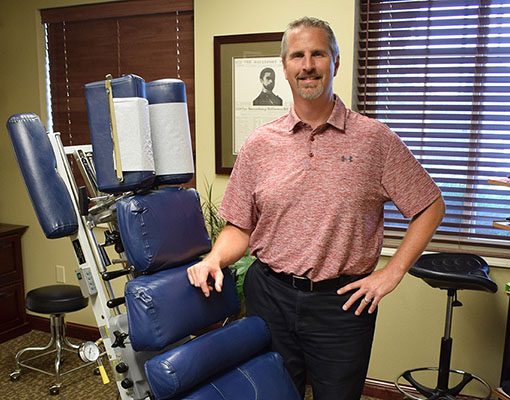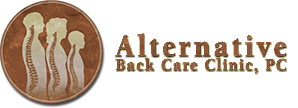Causes and Treatments
Headaches
ANALGESIC HEADACHES

These are associated with the extensive use of medications. If a person has quickly discontinued pain medications such as analgesics, opioids, or antimigraines, headaches on a daily or nearly daily basis can occur.
BELL'S PALSY

The cause is unknown. Most patients just simply "wake up with it". The face appears expressionless on the involved side. In severe cases, the eye cannot close and the patient is unable to perform a smile on the affected side. Medical treatment is needed to keep the eye from drying out. These cases have improved significantly with chiropractic treatment. Although 60% of cases recover completely without any treatment, spinal manipulation and muscular goading techniques usually increase healing time.
CERVICOGENIC HEADACHES

These are headaches that arise from structures in the neck and occur on a daily basis. They can affect persons of any age or gender. They begin in the neck and/or suboccipital region (base of skull) and radiate into the skull, usually on both sides with one side being more dominant. Neck stiffness and loss of motion are associated.
CLUSTER HEADACHES

Target men usually in mid to late life. Located on one side of the head and around the eye for less than one hour usually. They usually occur at the same time of day, primarily 90 minutes after going to sleep. Associated symptoms may include nasal stuffiness and eye drainage. Sometimes knows as "suicide headaches" due to the severe pain.
MIGRAINE HEADACHES

The mechanism of migraines is not completely understood. Treatment costs are up to $17 billion per year. There are two types noted, classic and common. Only migraine headaches can be triggered by foods and worsen with exercise. No specific time of day for onset of one.
Classic - There is an aura involved at least 10-20 minutes preceding the headache. The migraine is usually on one side of the head only and lasts many hours, often into the next day. Nausea, vomiting, photophobia (light sensitivity), and phonophobia (sound sensitivity) are associated symptoms.
Common - They develop 75% of the time in the morning. More likely influenced by monthly fluctuations in female hormones. No aura associated. Sometimes nausea occurs.
SINUS HEADACHES

Due to acute infection and typically on one side of head. Sinus cavities may be very tender to the touch. Yellow or green nasal discharge is usually present.
SINUS PROBLEMS

Sinus problems are extremely prevalent in today's world. Sinus infections are associated with green or white exudates (mucus) that dispels from the nostrils. These problems are difficult to treat. Conservative measures of treatment in our office consist of spinal adjustments to the neck (primarily the C2 vertebrae) and trigger point therapy. Some homeopathic remedies also help alleviate symptoms. We now offer new technology that has been shown extremely useful for treating sinusitis and sinus problems. It is called low level laser therapy or cold laser therapy. Call us for details or look under the Our Services section.
TENSION HEADACHES

The most common type of headache and is the result of sustained tension of the scalp and neck musculature with vascular changes as well. Cervical trauma (e.g. whiplash), stress, smoking, alcohol, weather changes, menstruation, chronic medication use, anxiety, and depression are contributing factors. They usually start gradually and progress to moderate levels of pain. The duration lasts between 30 minutes to seven days, but may be continuous. Most common toward the end of the day and the feeling is "hat-band" in location on both sides of the head.
TMJ (TEMPORO-MANDIBULAR JOINT) DYSFUNCTION

The TMJ is the joint formed by the temporal portion of the skull with the lower jaw (mandible). The TMJ is the most complex joint in the body. Between these two bones is a disc similar to the ones of the spine. With improper motions or injury, this disc can degenerate and lead to pain syndromes, often producing "clicking" noises, but jaw clicking in and of itself does not mean that you have TMD. Likewise, not every TMD has jaw clicking. TMD is a term for a broad range of symptoms and signs such as radiating pain into the face, neck, or shoulders, painful clicking or grating when opening or closing mouth, headaches, earaches, dizziness, hearing problems, difficulty swallowing, to name a few. A lot of TMJ-type symptoms can actually be caused by pain referred by pressure on the cervical nerves controlling that area. This pressure is mainly caused by spinal misalignment and muscular tension.
Treatment consists of spinal manipulation, TMJ manipulation (light-force if needed), relaxation techniques, and trigger point therapy.
Why Choose Us?

Because Dr. Bunkers LOVES his job!
-
We do not
require lengthy treatment plans
-
We treat
neck and back problems, headaches, joint problems of the arms and legs such as shoulders, knees, etc.
-
We treat
the entire family from infants to senior citizens
-
We focus
on treating the problem and getting you functioning as soon as possible
-
We help
with your insurance questions
-
We will
refer out for second opinions if your condition does not improve
